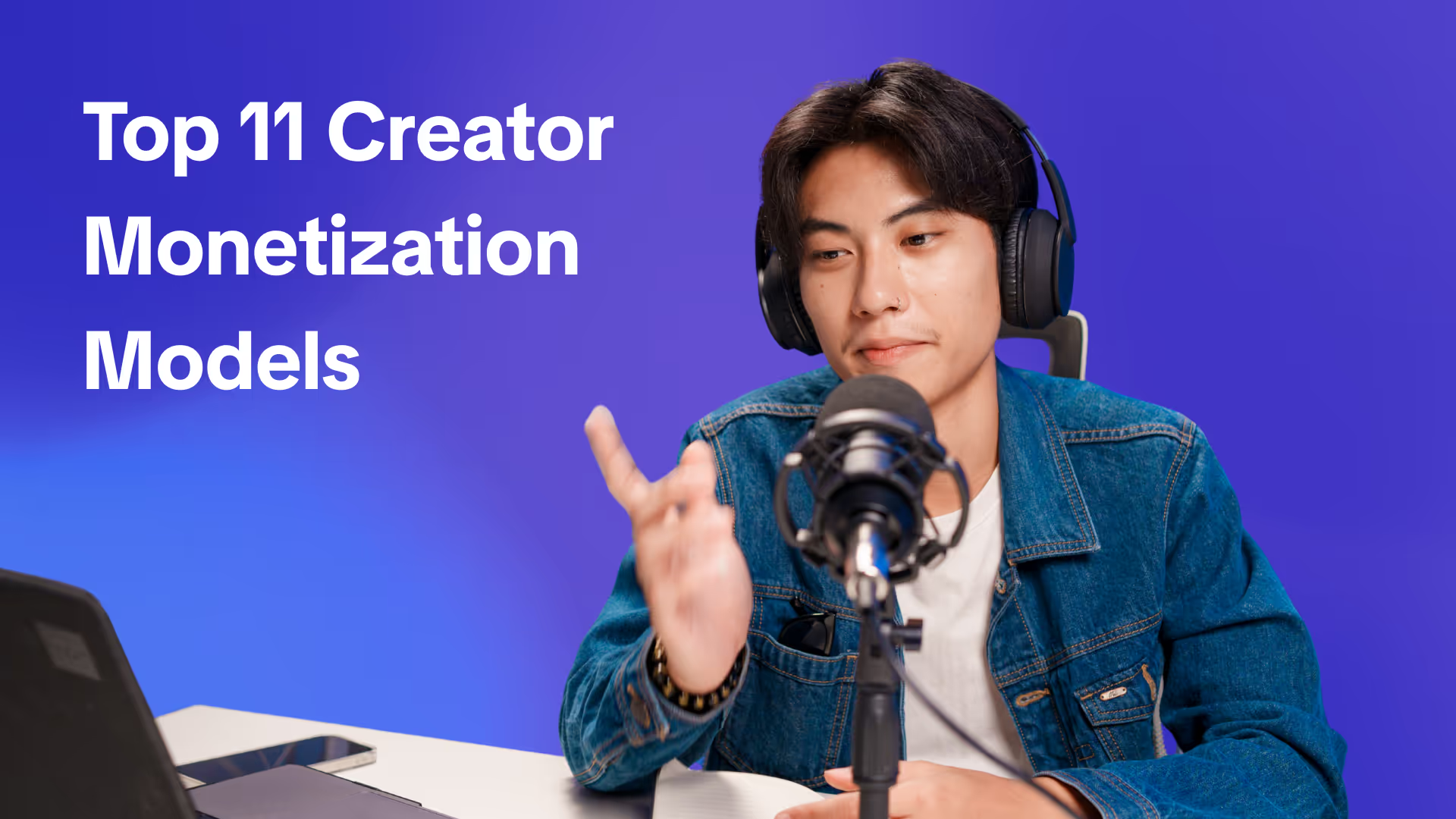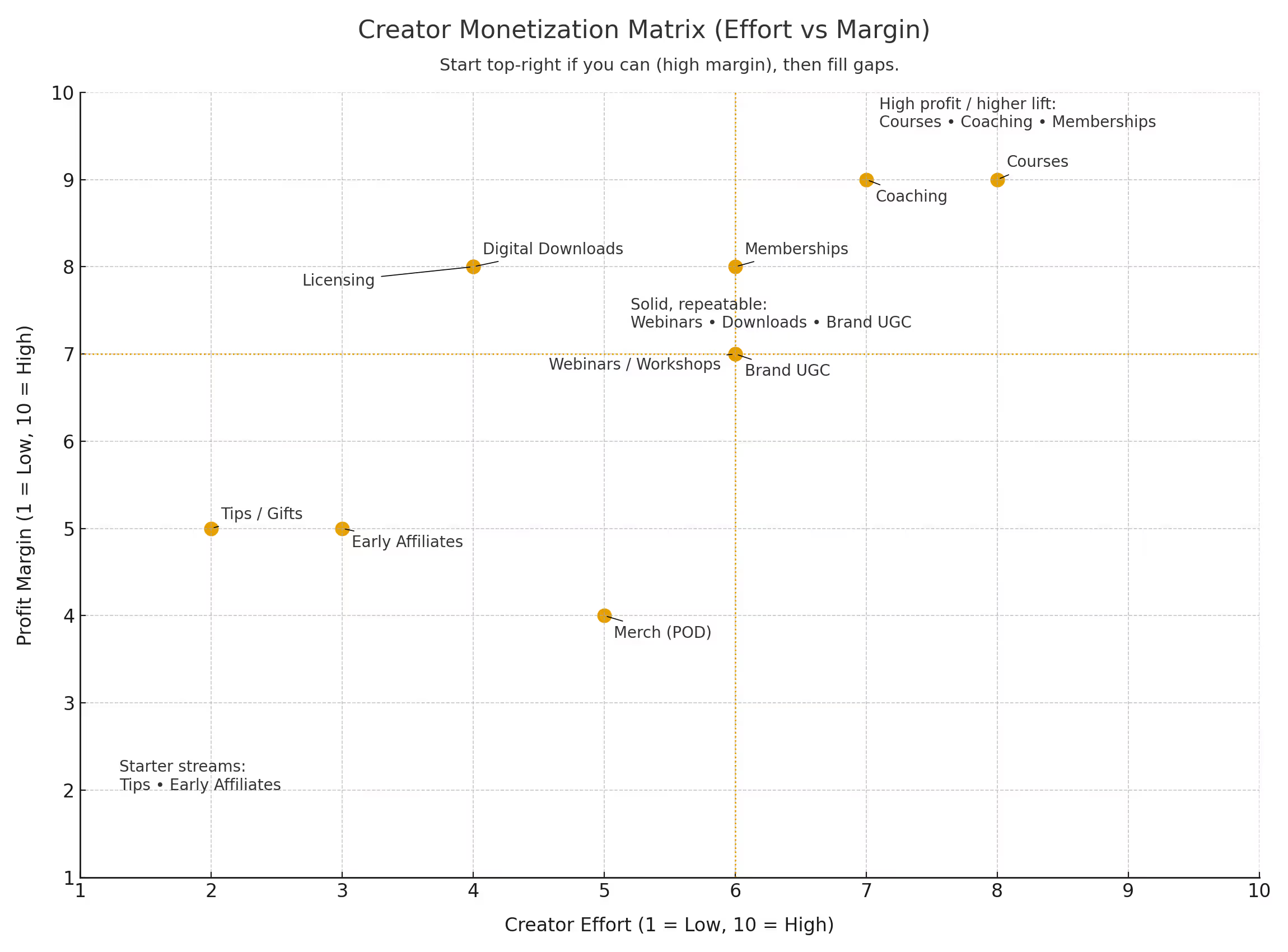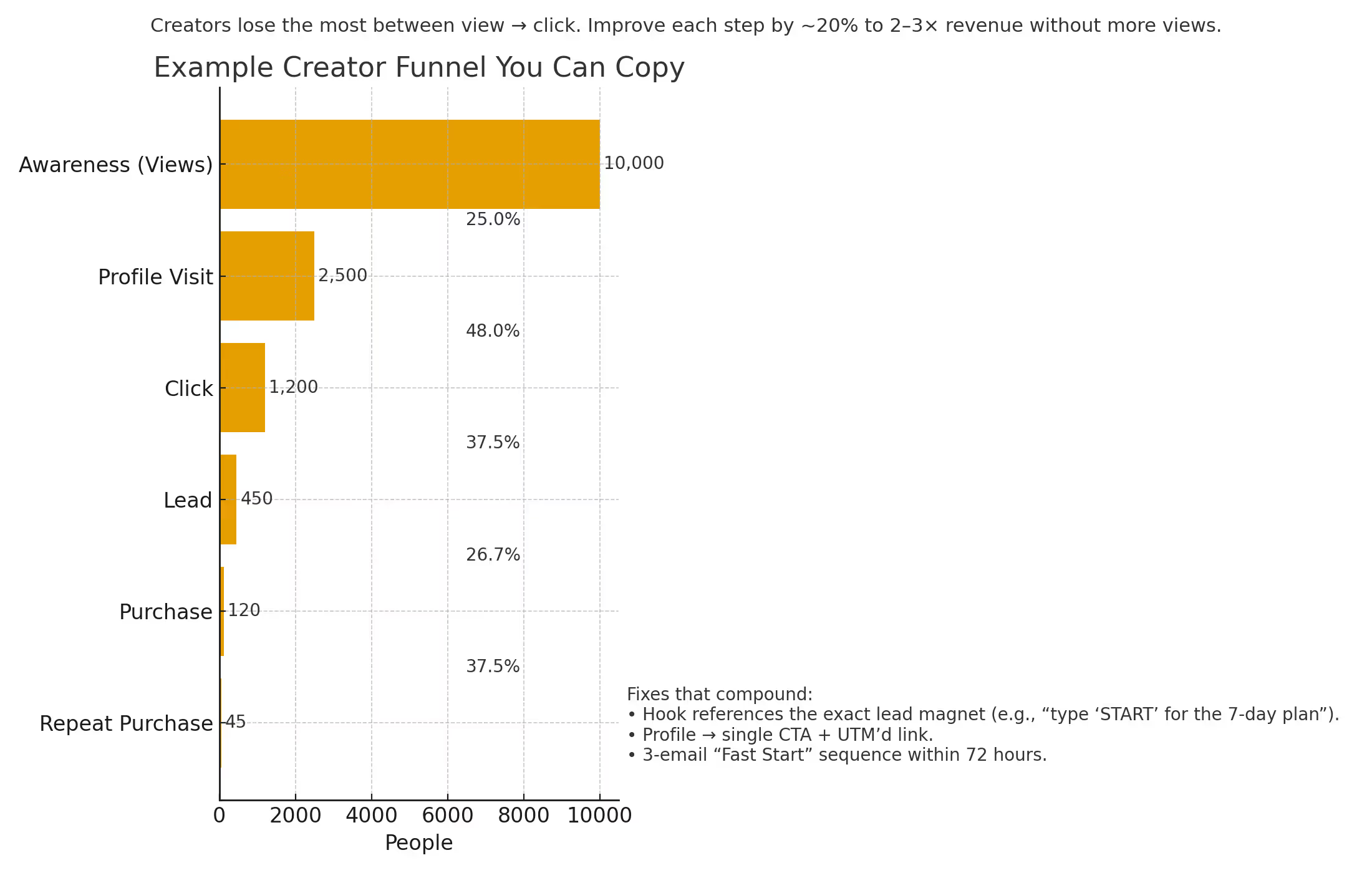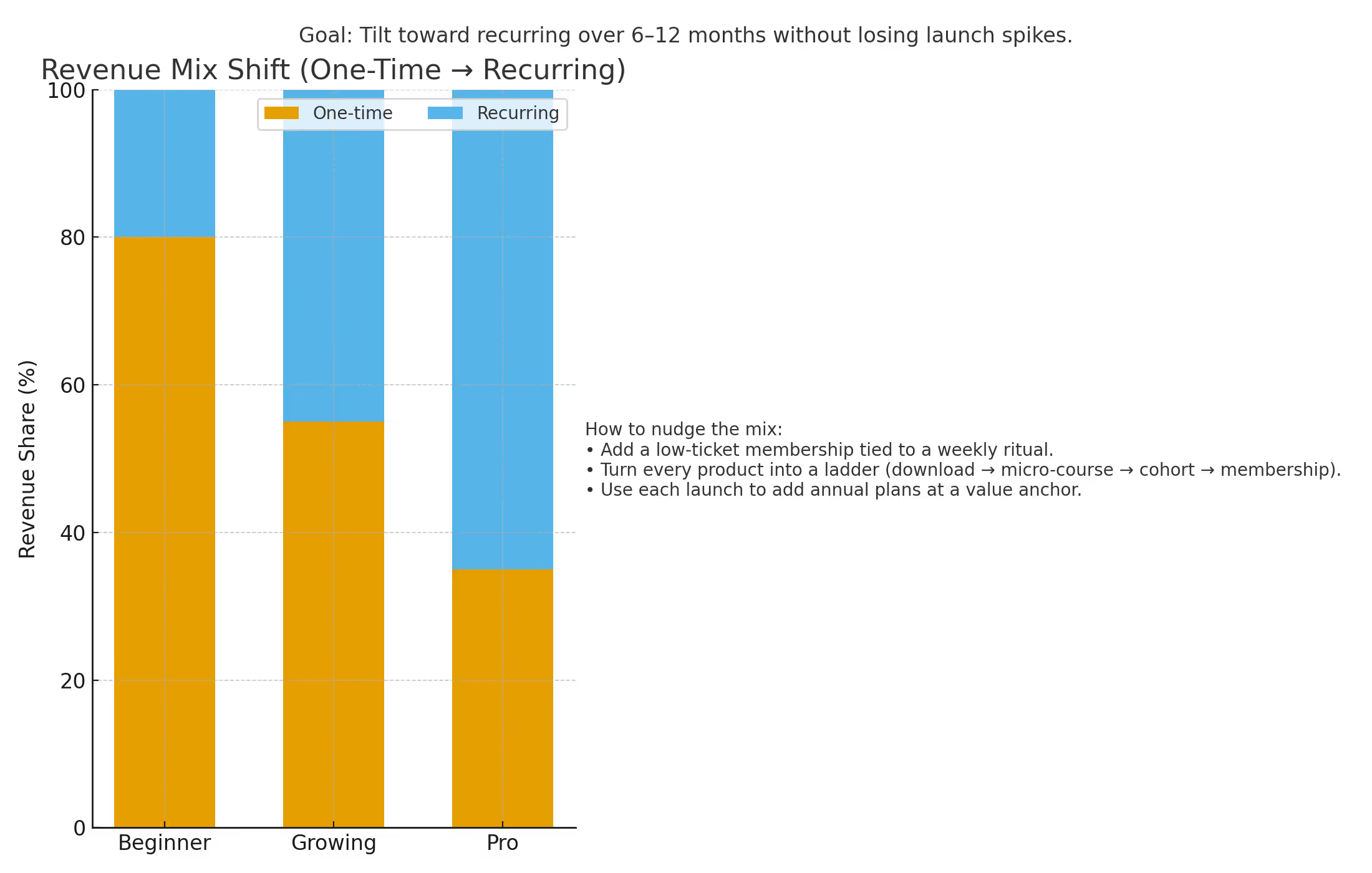
Creator Monetization in 2026: 15 Proven Revenue Models, Playbooks & Benchmarks
If you’ve outgrown “post and pray,” this creator monetization guide is your revenue-sidekick. It goes beyond generic lists to show what to sell, when to sell it, and how to stack streams so your income compounds—no matter your audience size.
TL;DR
- Start with one high-margin offer on Rally.Fan (download, coaching, or workshop), then layer recurring (memberships) and scalable streams (courses, affiliates).
- Use the Monetization Matrix below to pick the right stream for your time/bandwidth.
- Focus on repeatable funnels (lead → nurture → offer); ads/brand deals are great accelerants, not foundations.
- Policies change—plan with platform proof: YPP rules, TikTok Gifts, IG Badges, Patreon billing (citations below).

15 Revenue Models (What to sell + quick playbook)
1) Digital Downloads (templates, presets, toolkits)
What it is
Downloadable products creators sell directly—templates, presets, e-books, planners, swipe files, PDF guides.
How it works
Create once, upload to your storefront, and deliver instantly after checkout. No shipping, no inventory, unlimited sales capacity.
Where it’s strongest
Tutorial/education and creative niches across YouTube, Instagram, TikTok, and blogs.
Pros
- Fast to launch with simple tools
- Near-zero COGS, high margins
- Evergreen: can sell indefinitely
Cons
- Requires ongoing promotion
- Low ticket unless bundled
- Quality/utility must be obvious
Example
A short-form video editor sells a “30 Reels Hooks” PDF + caption templates as a starter product.
2) Micro-Courses (1–2 hour sprints)
What it is
Compact video trainings focused on a single outcome (e.g., “Edit a viral short in 90 minutes”).
How it works
Teach live once, record the session, package it with a worksheet/checklist, and sell evergreen.
Where it’s strongest
Skill niches where learners want speed: editing, design, landing pages, creator ops.
Pros
- Higher AOV than downloads
- Quick to produce and update
- Validates demand for a flagship course
Cons
- Needs a crisp promise and syllabus
- Q&A/support requests may follow
- Perceived value tied to outcomes
Example
A YouTuber sells a 75-minute “Thumbnail Masterclass” with a PSD pack and checklist.
3) Coaching / Strategy Calls
What it is
Paid 1:1 or small-group time to diagnose problems and prescribe an action plan.
How it works
Booking page → intake form → 30/60/90-minute call → written recap + next steps.
Where it’s strongest
High-intent audiences; B2B skills; creators with visible case studies.
Pros
- Highest $/hour and instant cash flow
- Direct market research for future products
- Strong testimonials
Cons
- Not scalable; calendar-bound
- Client fit varies
- Requires clear boundaries/scope
Example
A TikTok growth coach sells 60-minute audits with a 30-day content plan.
4) Webinars / Workshops (live or cohort)
What it is
Live teaching with interaction, time-boxed for urgency.
How it works
Free or paid registration → live session → Q&A → replay access → post-event offer.
Where it’s strongest
Education and transformation topics where live feedback matters.
Pros
- High trust and conversion
- Creates reusable assets (replays, clips)
- Great list-building
Cons
- Requires promotion and event ops
- Attendance drop-off if not reminded
- Tech reliability matters
Example
A fitness creator runs a paid “Form Fix” workshop, then sells the replay + program.
5) Memberships / Communities
What it is
Recurring access to resources, events, and a peer group.
How it works
Weekly ritual (office hours, drops, challenges) + content library + member perks—charged monthly or annually.
Where it’s strongest
Niches with ongoing wins and community motivation (fitness, writing, editing, business playbooks).
Pros
- Predictable MRR
- Retention flywheel and referrals
- Natural upsell path
Cons
- Consistency required to avoid churn
- Community moderation workload
- Onboarding must be tight
Example
A design creator offers a $19/mo “Creator Lab” with weekly critiques and template drops.
6) Courses (flagship, multi-module)
What it is
A structured curriculum that delivers a full transformation with milestones and assessments.
How it works
Draft from coaching FAQs and workshop recordings; add modules, worksheets, quizzes; launch in cohorts then evergreen.
Where it’s strongest
Complex skills where systems matter (editing pipelines, marketing, coding).
Pros
- High margin and authority building
- Scales well once produced
- Anchor for your product ladder
Cons
- Heavier production/support
- Refund risk without proof
- Needs student success systems
Example
A creator launches a 6-week “Short-Form Studio” with office hours and capstone projects.
7) Affiliate Partnerships
What it is
Earn commission for products you recommend and actually use.
How it works
Create comparison content, tutorials, and a “my stack” page; disclose links; track in analytics.
Where it’s strongest
Tool-driven niches (gear, apps, SaaS) and evergreen tutorials.
Pros
- Compounds over time
- No fulfillment or support
- Pairs well with SEO and YouTube
Cons
- Variable payouts/policies
- Trust at risk if you shill
- Needs traffic to scale
Example
A creator publishes “My Editing Stack: Camera → NLE → Plugins” with affiliate links and a setup guide.
8) Brand Deals
What it is
Paid sponsorships on your owned channels.
How it works
Send media kit + rate card; pitch 2–3 creative angles; scope usage rights (organic vs. paid/whitelisting).
Where it’s strongest
Clear audience niche with measurable outcomes (tutorials, reviews, challenges).
Pros
- Large cash injections
- Relationship compounding into series
- Cross-promotion opportunities
Cons
- Deliverables pressure/timelines
- Audience fit must be right
- Negotiating usage rights is nuanced
Example
A productivity creator sells a sponsored “Deep Work Setup” video with optional paid-ads rights.
9) UGC for Brands (whitelisting/paid ads)
What it is
You produce ad-style content for brands to run on their accounts or ads—no audience required.
How it works
Spec reel → packages (3 hooks × 2 edits × raw) → price usage and paid media rights separately.
Where it’s strongest
DTC brands needing a relatable face and constant creative testing.
Pros
- Works even with a small following
- Repeatable retainers
- Creative portfolio grows fast
Cons
- Revisions/approvals
- Rights and exclusivity negotiations
- Burnout if not productized
Example
A creator delivers six TikTok ad variants for a skincare brand, including raw files for iteration.
10) Merch (Print-on-Demand)
What it is
Apparel and accessories printed on demand with your designs.
How it works
Connect POD service, launch limited drops, bundle with digital perks to increase perceived value.
Where it’s strongest
Identity-driven communities, slogans, memes, inside jokes.
Pros
- Low upfront cost
- Community pride and reach
- Great for event spikes
Cons
- Lower margins than digital
- Returns/fulfillment if not fully POD
- Design quality sets ceiling
Example
A comedy creator drops a limited “Inside Joke” hoodie with a bonus ringtone download.
11) Sponsorships (newsletters, livestreams, podcasts)
What it is
Paid placements across your newsletter, streams, or podcast.
How it works
Media kit → CPM/CPE pricing → bundle placements (e.g., 4 weeks) for better ROI and predictability.
Where it’s strongest
B2B or niche audiences with consistent cadence and high trust.
Pros
- Lump-sum + recurring deals
- Less algorithm volatility
- Cross-channel packaging
Cons
- Requires schedule discipline
- Advertiser fit matters
- Reporting expectations
Example
A weekly newsletter sells a top-slot sponsor package + two mid-roll podcast reads.
12) Licensing / White-Label
What it is
You grant businesses rights to use your content, templates, or curriculum.
How it works
Define scope (media, territory, duration) → flat fee or royalty → optional update fee.
Where it’s strongest
Education platforms, corporate training, SaaS onboarding.
Pros
- Evergreen B2B income
- No audience needed
- High perceived value
Cons
- Contract complexity
- Exclusivity can limit future deals
- Requires version control
Example
A creator licenses a 12-video onboarding series to a SaaS company with annual renewal.
13) Live Streams + Tips/Gifts
What it is
Real-time shows where viewers tip through platform tools (badges, gifts, supers).
How it works
Weekly themed streams → milestones/shoutouts → repurpose highlights → plug your core offers.
Where it’s strongest
Interactive niches: music, gaming, live tutorials, Q&A.
Pros
- Immediate cash + strong community
- Great discovery and practice
- Clips fuel short-form growth
Cons
- Time-bound; inconsistent revenue
- Energy intensive
- Eligibility varies by platform/region
Example
A guitarist runs “Request Night,” earns tips, and funnels viewers to a chord-pack download.
14) Services (editing, design, audits)
What it is
Productized services with fixed scope and price.
How it works
Menu with clear deliverables/turnaround → Stripe checkout → standardized delivery + revision policy.
Where it’s strongest
Skills you already perform for your own content—editing, thumbnails, landing pages, audits.
Pros
- Fastest route to cash
- Seeds testimonials and product ideas
- Easy to understand and buy
Cons
- Capacity-limited
- Client management overhead
- Scope creep without rules
Example
A shorts editor sells “3 Reels Pack—48-hour turnaround” with one revision.
15) Paid Newsletters
What it is
Subscription email with premium analysis, curation, or templates.
How it works
Free tier grows the list → paywall archive/deep dives → annual plan with value anchor.
Where it’s strongest
Insights-driven niches (creator growth, finance, SaaS, niche research).
Pros
- Owned audience and stable MRR
- Sponsor upside at scale
- Portable across platforms
Cons
- Consistency required
- Churn if value slips
- Research time
Example
A creator runs a $10/mo “Creator Signals” newsletter with monthly deep dives and a templates vault.

Platform Realities (so your plan ages well)
- YouTube Partner Program. YT introduced a two-tier path (early benefits at 500 subs; ad revenue unlocks at 1,000 subs with watch-hour/Shorts thresholds). Always check current thresholds before planning ad-rev. YouTube
- TikTok LIVE gifts convert best during structured segments (Q&A, reveals). Check eligibility and diamonds/gifts rules in the Help Center. TikTok Support+1
- Instagram Badges pay you during Lives (Creator/Business accounts, regional eligibility applies). Instagram Help Center
- Patreon billing/fees: subscription billing charges on join date monthly; fee structures vary by plan & payment method—bake into pricing. Patreon Help Center+1
- Policy drift: YouTube’s 2025 clarification targeted spammy, mass-produced AI slop—original, valuable AI-assisted content remains monetizable. Build authenticity into your workflow.

Pick-Your-Path Monetization (3 fast blueprints)
A) Starter (Audience <10k)
- This month: 1 digital download ($9–$29) + 1 live workshop ($29–$79).
- Distribution: 4 Shorts/week → pin comment CTA → Auto-DM keyword “START.”
- Metric: 50 first customers.
B) Growing (10k–100k)
- This quarter: Micro-course ($99–$199) + evergreen webinar + 2–3 affiliate anchors.
- Distribution: YouTube + IG Reels; weekly email; UGC pitches.
- Metric: 20% of buyers take an upsell.
C) Pro (100k+ or strong niche)
- This quarter: Membership ($10–$29/mo) + quarterly cohort ($399–$999) + sponsors.
- Distribution: Newsletter + Shorts + community events.
- Metric: 6-month retention ≥60% on membership.
Monetization Ops: Offers that actually convert
- Offer Equation: Result (clear) + Constraint (timeframe) + Mechanism (your unique process) + Proof (screenshots/wins).
- Page: Big promise above the fold → 3-bullet outcomes → credibility row → FAQ that reduces refund fears.
- Price: Start smaller than you think; raise with proof (test in cohorts first).
Compliance & Music Notes (short & sweet)
- Business/brand content on TikTok and IG needs the right music rights; when in doubt, use platform-approved catalogs or licensed tracks. (This is especially relevant if you’re a Business account.)
- Disclose sponsorships and affiliate links. Treat trust like a renewable currency.
FAQ (straight answers, zero fluff)
What should I launch first?
A tiny, high-value product you can ship this week: a download (template, checklist) or a micro-course (45–90 min). It proves willingness to pay, gives you testimonials, and seeds your flagship.
How do I avoid feast/famine?
Add a weekly ritual (office hour, drop, challenge) and put it behind a low-ticket membership. Keep launching one-time offers, but route buyers into recurring.
Are brand deals worth it early?
Yes—if you package UGC (no audience requirement), offer 3–5 deliverables, and price usage rights separately (organic, paid ads, whitelisting).
How much audience do I need to start?
None. Monetization is a conversion game, not a follower contest. Start with 50–100 warm viewers, sell a $9–$29 asset, and iterate.
What price points convert best for first products?
- Download: $9–$29
- Micro-course/workshop: $49–$199
- Coaching call: $99–$299
Prove value at the low end, then raise with proof.
What simple funnel should I copy?
Short video → single bio link (UTM’d) → landing page with 1 CTA → 3-email “Fast Start” sequence in 72 hours (deliver, case study, offer).
What if I don’t have a clickable link yet?
Use pinned comments + Auto-DM keyword (“type START”), IG bridge, and an on-screen QR + vanity URL. Give one clear path—repeat it verbally, on-screen, and in captions.
How many products before launching a membership?
Two or three. Make sure each has a repeatable “win,” then bundle them into a library + weekly ritual so members get compounding value.
What metrics should I watch weekly?
Click-through rate from views → profile; profile → link; email opt-in rate (target 25–40% on lead magnets); checkout conversion (3–8% baseline); and monthly retention for memberships.
How do I use affiliates without feeling salesy?
Limit to 3 core tools you genuinely use. Create one comparison page + one “stack” post, and mention them contextually inside your content.
How do I handle refunds and chargebacks smartly?
Keep a clear refund policy (e.g., 7–14 days for courses; none for instant downloads unless defective). Add a pre-purchase FAQ and require a quick form to capture reasons—use that data to tighten your offer.
What about music and disclosure?
If you’re promoting products/services, stick to platform-approved music or licensed tracks, and always disclose sponsored and affiliate relationships. Trust compounds.
Conclusion: Your 90-Day Revenue Plan
You don’t need more views—you need one clear offer, one clear path, and one weekly ritual. Start with a tiny product, prove demand, then stack recurring and scalable streams.
Copy-and-ship checklist:
- This week: Publish one $9–$29 download + landing page (UTM on your link).
- Next 14 days: Record a live workshop; turn the replay into a micro-course.
- Day 1–21: Run the 3-email “Fast Start” sequence for every new lead.
- Day 30–60: Launch a membership tied to a weekly ritual; invite all buyers.
- Day 60–90: Add UGC or a single sponsor, plus 2–3 affiliate anchors.
Stay boringly consistent: one offer, one CTA, one weekly rhythm. That’s how creators turn momentum into money—without chasing algorithms. If you want, tell me your niche and audience size; I’ll tailor the 90-day plan with exact price points, CTAs, and an email sequence you can paste today.





